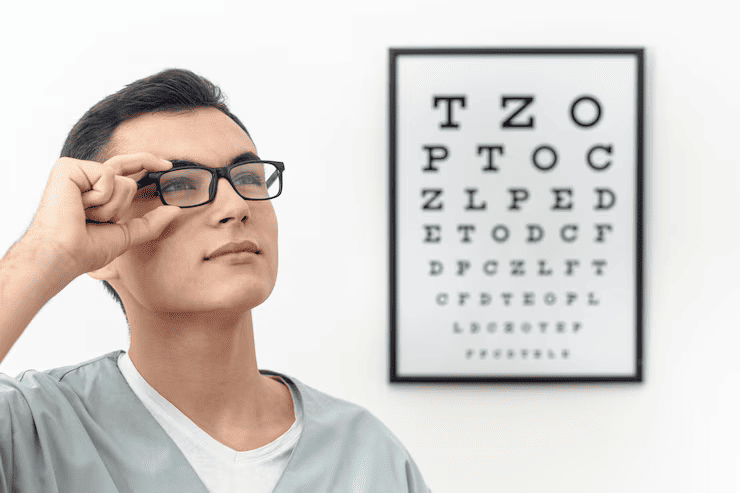Understanding Low Vision
Low vision refers to a significant, long-term visual impairment that cannot be fully corrected with glasses, contact
lenses, or surgical interventions. This condition makes it difficult for individuals to perform daily tasks effectively.
Signs of Low Vision:
You might have low vision if you experience difficulty with glasses:
- Reading books, newspapers, or digital screens
- Driving safely
- Recognizing faces
- Differentiating colours
- Watching television or using a computer clearly
Types of Low Vision
The nature of low vision varies depending on the underlying eye condition. Common types include:
- Central Vision Loss – Difficulty seeing objects in the center of vision
- Peripheral Vision Loss – Trouble seeing things from the sides (tunnel vision)
- Night Blindness – Reduced ability to see in dim lighting or at night
- Blurry or Hazy Vision – Difficulty seeing objects clearly
- Reduced Contrast Sensitivity – Trouble distinguishing objects that lack strong contrast
Causes of Low Vision
Several eye conditions can lead to low vision, including:
- Age-related macular degeneration (AMD) – A leading cause of central vision loss in elderly population
- Diabetic Retinopathy – Vision loss associated with diabetes-related eye damage
- Glaucoma – Increased intraocular pressure in the eye leading to optic nerve damage
- Inherited Retinal Diseases – Conditions such as retinitis pigmentosa
- Trachoma – A bacterial infection causing scarring and blindness
- Nystagmus – Uncontrollable eye movements affecting vision
- Optic Atrophy – Damage to the optic nerve reducing vision clarity
- Myopic Degeneration – Progressive retinal damage due to severe nearsightedness
Low vision is more frequently seen in older individuals due to age-related eye diseases. However, injuries, genetic
disorders, or neurological conditions can also contribute to this impairment in any age group.
Diagnosing Low Vision
Eye doctors assess low vision through a comprehensive dilated eye examination. This painless test involves:
- Checking your ability to read both near and distant letters
- Evaluating central and peripheral vision
- Using eye drops to dilate the pupil and examine the internal eye structures
Can Low Vision Be Treated?
In most cases, low vision is permanent and cannot be fully corrected with glasses, surgery, or medication. However, some
treatments may help preserve or enhance remaining vision, depending on the underlying cause. It’s important to discuss
possible interventions with an eye care professional.
Strategies to Maximize Remaining Vision
While vision loss can be challenging, there are ways to adapt and maintain independence:
- Using brighter lighting at home and work
- Wearing anti-glare sunglasses to reduce light sensitivity
- Using a magnifying lens for reading or detailed tasks
For more severe vision loss, vision rehabilitation programs offer training and resources to help individuals adjust.
These may include:
- Learning to use specialized magnification devices
- Adjusting home environments for better navigation
- Accessing support groups or community resources
Low Vision Aids (LVAs)
Low vision aids help individuals make the most of their remaining sight by enhancing contrast, magnification, or
illumination. These assistive devices are broadly classified into optical and non-optical aids.
Optical Low Vision Aids
These devices use magnifying lenses to improve visual clarity:
- Prescription Glasses – Proper cycloplegic refraction and accommodation assessment are essential for children with low
vision. Specialized prescriptions can enhance their vision significantly.
- Magnifying Spectacles – Worn like regular glasses, they free up the hands for tasks like reading, sewing, or
fine-detail work. Users typically hold objects closer than usual for better focus.
- Stand Magnifiers – These rest above the reading material, ensuring the correct focal distance. They are particularly
beneficial for individuals with tremors or arthritis, and some include built-in lighting.
- Handheld Magnifiers – Compact and lightweight, these portable magnifiers help with on-the-go reading. Many models
feature integrated lighting.
- Telescopes – Useful for distance vision, these devices can be mounted on glasses or handheld, similar to binoculars.
Non-Optical Low Vision Aids
These assistive tools help improve accessibility and daily functioning:
- Talking watches and timers for time management
- Large-print materials (books, newspapers, playing cards, etc.)
- Audio books for reading assistance
- High-contrast devices such as telephones, thermostats, and remote controls
- Tactile aids like magnifying mirrors, textured labels, and needle threaders
- Writing, reading, and signature guides to aid precision
Electronic Low Vision Aids
Modern technology has introduced several digital solutions for low vision:
- Video Magnifiers – These devices provide an enlarged, high-contrast display of objects or text.
- Smartphones & Tablets – Many come with accessibility features such as adjustable text size, contrast settings, and
voice controls.
- Computers & TVs – Built-in screen readers and magnifiers help individuals navigate digital content more easily. A
large TV screen can serve as an enlarged monitor via an HDMI connection.
While digital technology has significantly improved accessibility, it is often used alongside traditional low vision
aids for a more comprehensive approach. Vision rehabilitation plays a crucial role in helping individuals make the most
of these tools.
Recycling and Donating Low Vision Aids
If you have low vision devices that are no longer in use, consider donating them instead of discarding them. Many vision
rehabilitation centre, non-profit organizations, libraries, and retirement homes accept these devices. Some
organizations refurbish them for redistribution to under-served communities worldwide, ensuring that individuals in need
can benefit from assistive technology.



